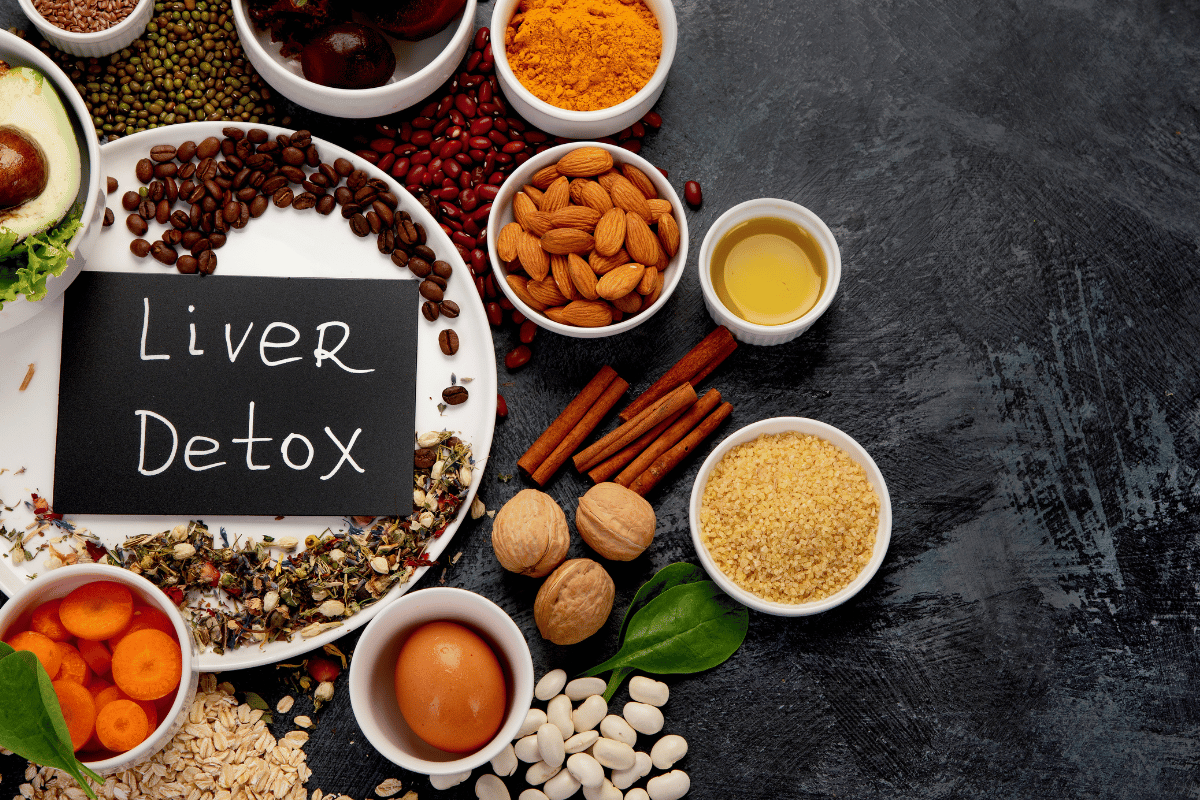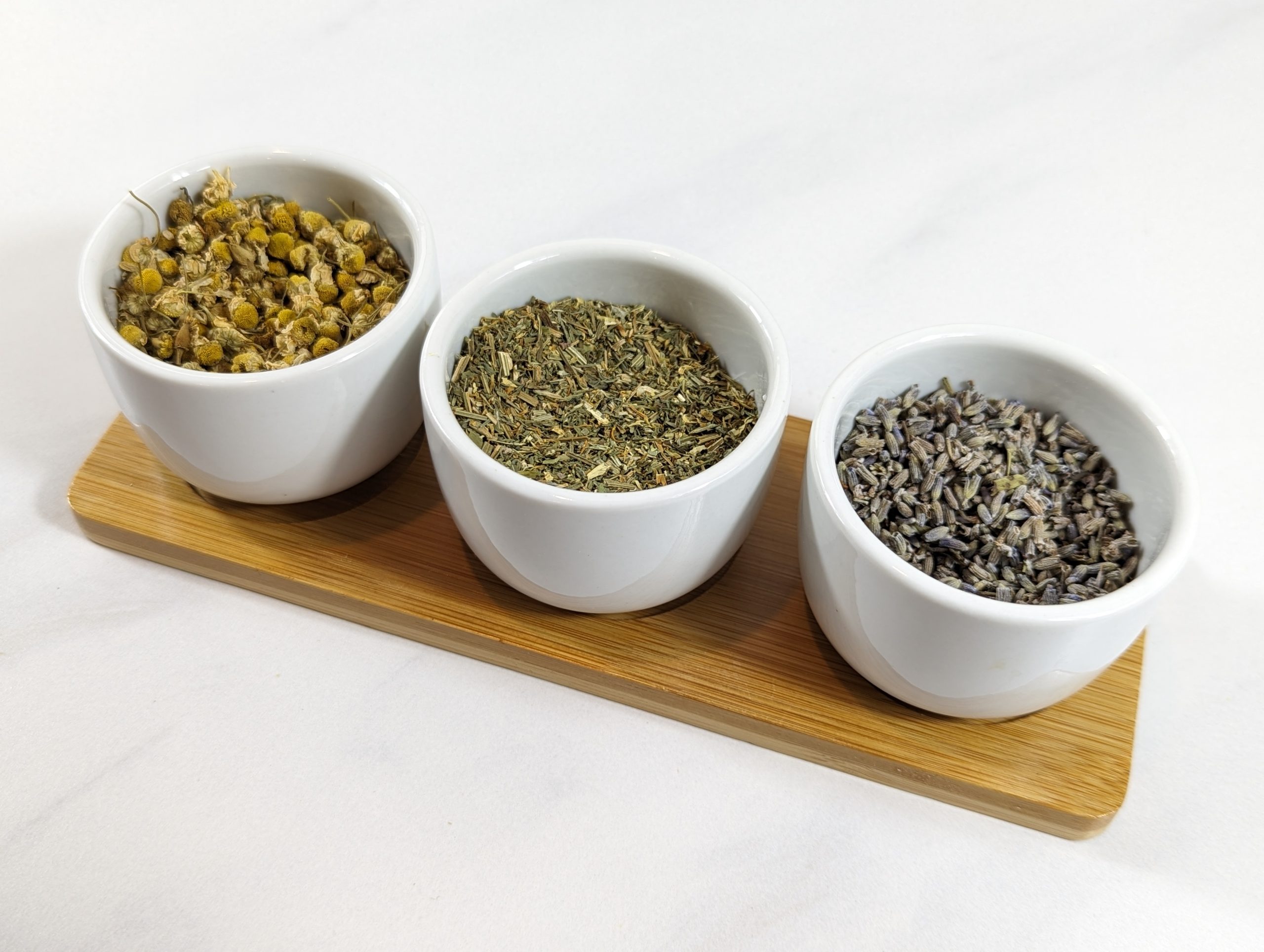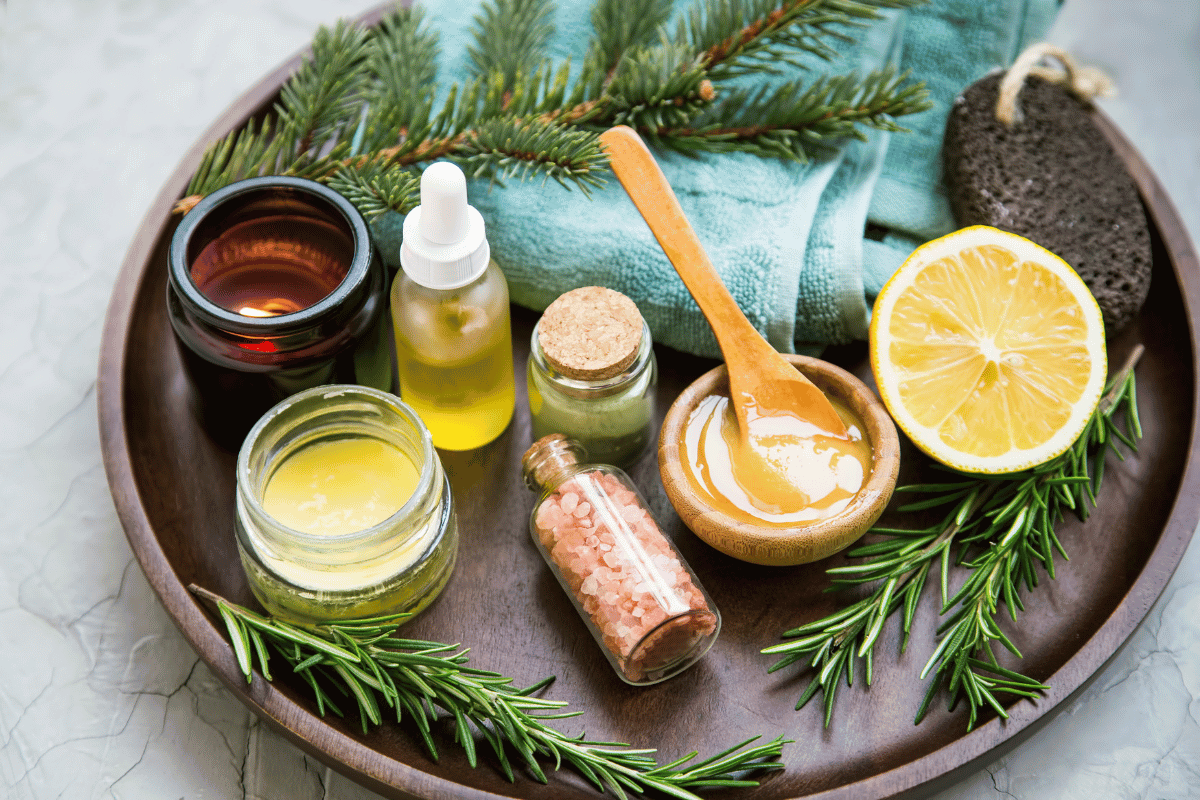Washing Cloth Diapers: A Simple How-to Guide with Steps
In this post, I will show you washing cloth diapers (reusable diapers) is very simple and easy. This guide will take you through the process step by step. I have been cloth diapering for many years and will share some tips and tricks I have learned along the way.
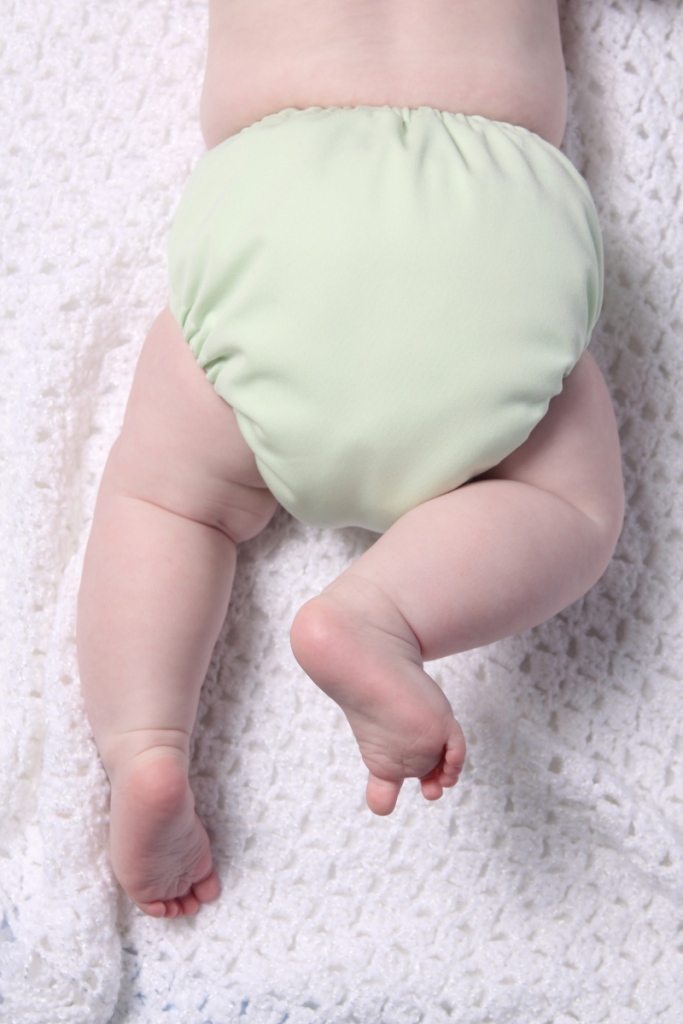
This post contains affiliate links, which means I make a small commission at no extra cost to you. You can view our privacy policy here.
Washing cloth diapers
I know it can seem intimidating when you consider washing cloth diapers. I promise it is really simple and straightforward, even less messy than you’d imagine. There are many ways to wash cloth diapers. Everyone will end up with a wash routine that works best for them. This can be based on their equipment, type of baby stool (poop), type of cloth diapers, and detergents.
We will go over the equipment and supplies needed to wash cloth diapers. As well as different options on how to wash and dry cloth diapers.

Before you start washing cloth diapers
Every cloth diaper manufacturer has their guidelines for care and use. Many companies provide precise instructions for their products. Make sure to check the company’s website to avoid problems with warranties or potentially damaging your cloth diapers in the washing process.
Dirty diaper storage
Part of preparing for washing cloth diapers is preparing how you’re going to store the dirty diapers waiting to be washed. There are wet bags, made for just this purpose. Wet bags come in different styles, colors, and sizes. Some can be used like a normal trash bag because the elastic opening fits inside a basic trash can. Others will have handles you can use to hang off of something and have a zipper to close it. We’ve used both types and currently hang our wet bag from the dresser knobs. I recommend when your baby is eating solid foods and their poop can become stinky get a garbage can that closes and insert a pail liner into it. It will help keep the smell in like a diaper genie for disposables does.
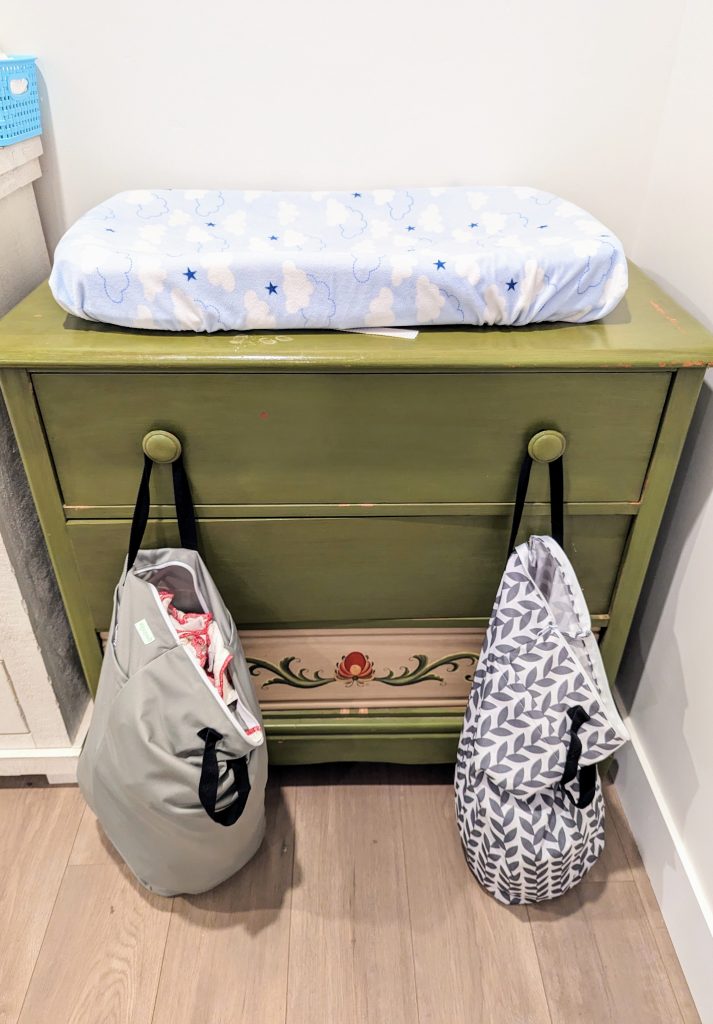
What goes in?
Knowing what can go into the wash is very important. If your baby is still on a liquid diet (breastfeeding or formula), their waste is still water-soluble, which means that you can just throw their dirty diapers straight into the washing machine. If your baby has started eating solid foods, however, you will need to rinse the solid waste off into the toilet before putting it into the washing machine. This can easily be done with a diaper sprayer, or using the dunk and swish method. Either method, I recommend doing this before putting the soiled diaper into your wet bag. Removing the solid waste beforehand will help prevent staining and hardening onto the diaper.
If you are using pocket diapers, it is a good idea for you to remove the insert before putting the wet diaper into the wet bag. This will make it a lot easier and more time-efficient on wash day. If you choose to not do this, you will have to remove each diaper from the bag to do so before putting them into the wash. This is a step I would not like to do. Generally, they have become stinky diapers by this time and I would much prefer to just dump and wash.
Developing a cloth diaper wash routine
Adding washing cloth diapers to your routine will only add a couple of extra loads a week. I do not recommend letting your soiled cloth diapers sit in a wet bag or pail for too long. The urine and baby poop smell can intensify as they sit. Generally, you will be doing a load of wash every 2-3 days. Any longer than this mildew and stains may set in, and you’ll need to strip the diapers (see below on stripping diapers).
I have found that cloth diaper laundry is very satisfying. I much prefer stacking cloth diapers than taking a trip with all the children in tow, buying disposable diapers, and then having more plastic and chemicals end up in our landfills.
There are many variables when washing cloth diapers. Washing machines vary, laundry detergents vary, and water conditions vary (hardness, acidity/alkalinity, etc.). Try different ways and combinations to find out what works best for you. See below for tips and tricks on these variables.
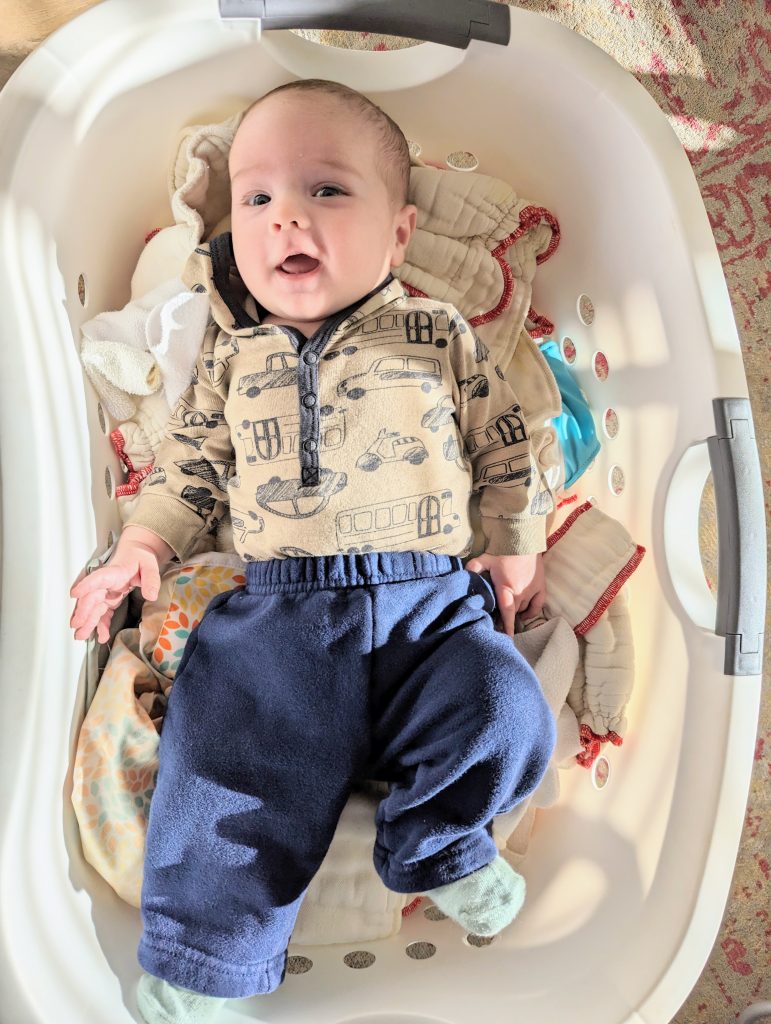
Equipment and supplies
As with everything, there are certain essentials that you will need to have in some form. These will also depend upon your budget. The essentials are what I consider the basics to being successful at washing cloth diapers. There are always variations to these. You can wash cloth diapers by hand, but most of us today would much rather use a washing machine I’m sure.
The essential equipment and supplies for washing cloth diapers are:
- washing machine
- dryer
- hanging rack
- laundry detergent
- diaper sprayer
Washing machine
A top-loading washing machine will be far superior for washing cloth diapers. You can load the cloth diapers into the washing machine to soak before starting the cycle, and you can use a lot more water to help clean the cloth diapers. Front-loaders (HE machine) can get the job done as well but with a lot more finesse and extra cycles.
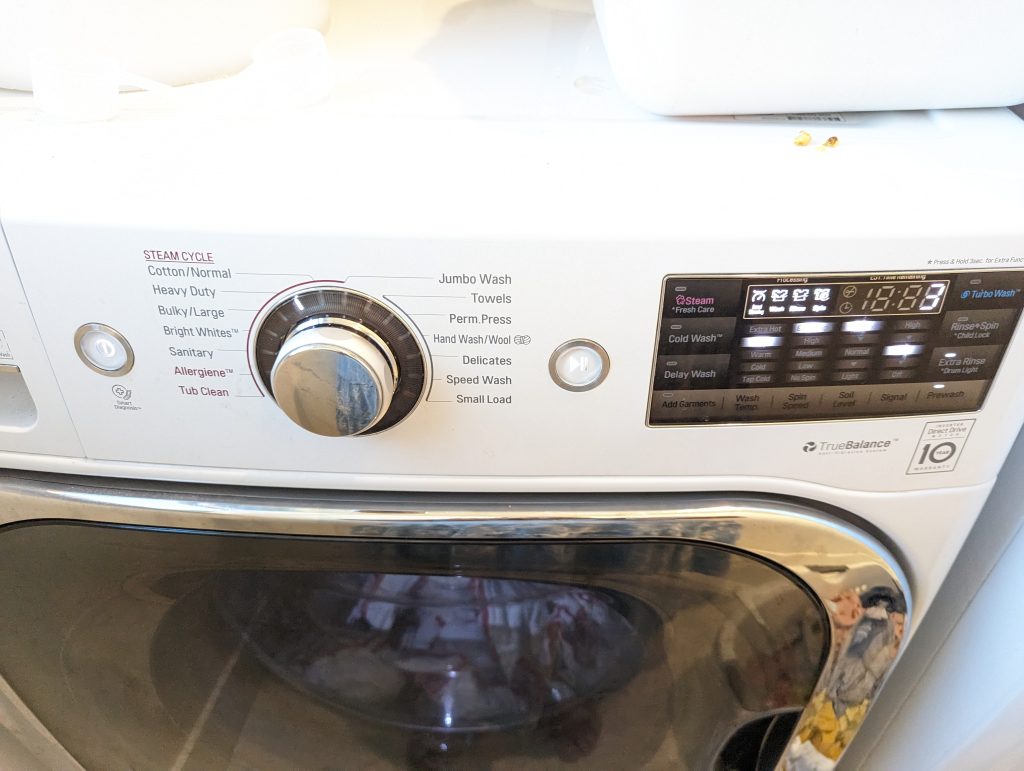
Dryer and hanging rack
A dryer is not required, as you can hang and line drying cloth diapers (my preferred way in the summertime). I do consider it essential because of the winter months and to save you time. You will need fewer cloth diapers on hand as well if the wash and dry cycles are shorter than if you line-dry them.
I consider a hanging rack, a clothesline, or anything similar to be essential. As stated above, I much prefer to line-dry my cloth diapers in the summer, in the sun. This aids in removing the stains on them.
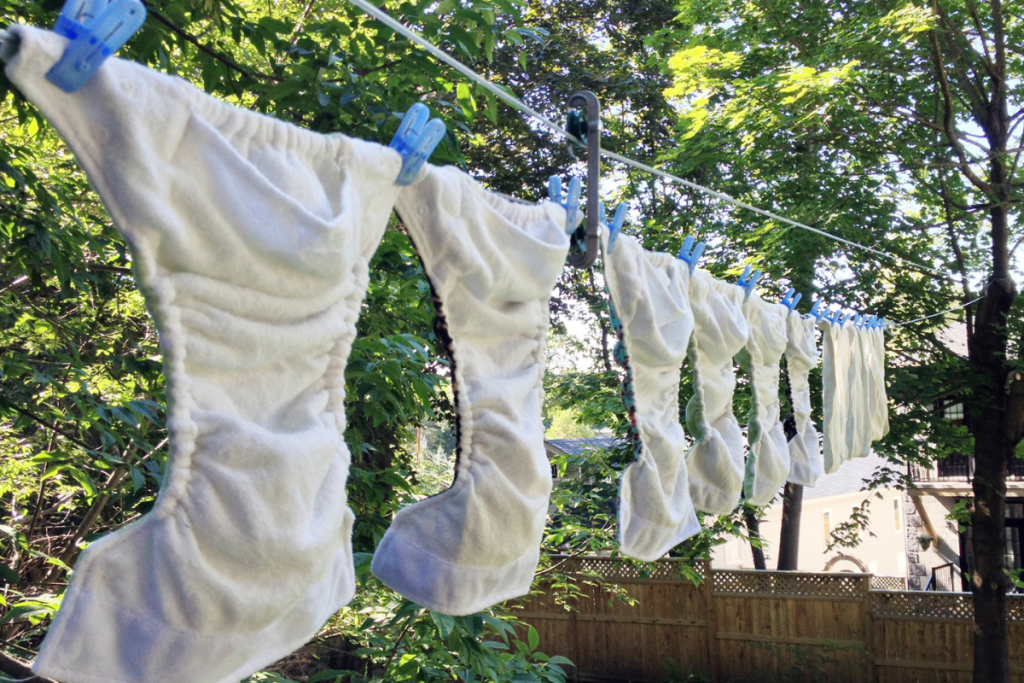
Laundry detergent
Laundry detergent is a big item for supplies. Many people who have chosen to use cloth diapers are doing it for health reasons, such as eczema. While many mainstream detergents consider themselves to be gentle and harmless, they are anything but that. My top suggestion is to make sure the detergent you have chosen is fragrance-free. That is a whole other topic, but know that fragrance can be any combination of chemicals that the manufacturer concocted. This is not gentle for your baby’s skin.
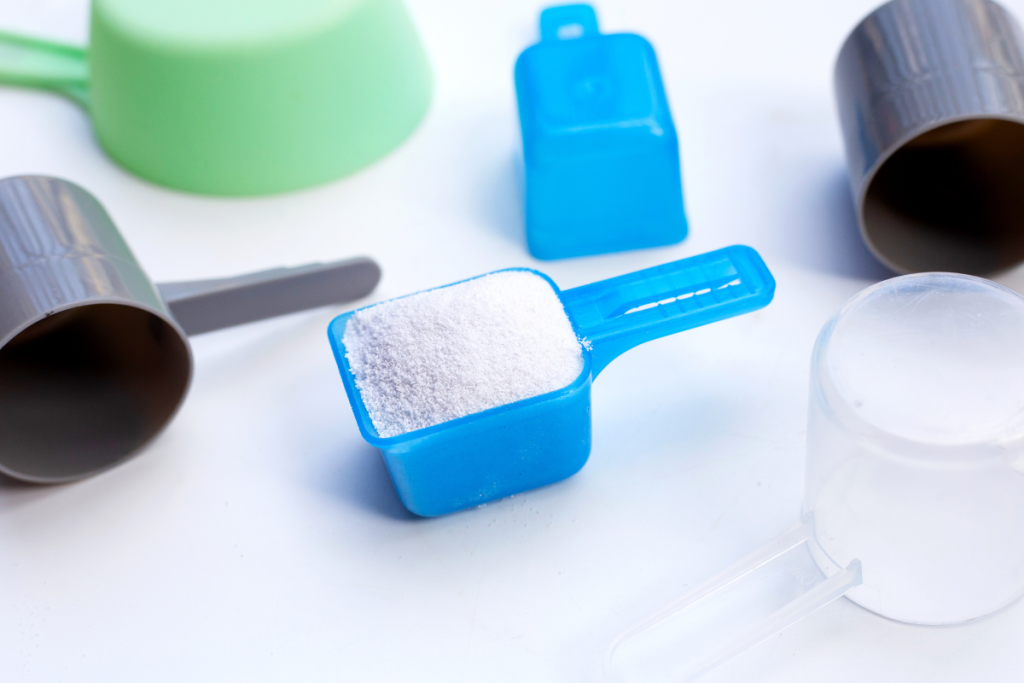
Other things to consider are optical brighteners, fabric softeners, and dryer sheets. These should never be used on cloth diapers as they will quickly degrade the quality of our diapers, leave a detergent residue, and prevent them from absorbing after use. Fabric softeners are designed to coat fabrics and I suggest avoiding them in general. Products designed to coat fabrics will cause buildup and possibly rashes and will make your covers leak and wick. This is not beneficial to you when trying to contain your baby’s waste.
Your best way to clean cloth diapers is by using a natural detergent or specific cloth diaper detergents that are not toxic or harmful and will not infringe on the absorbency of cloth diapers.
Diaper sprayer
A diaper sprayer should be used after your baby starts eating solid foods. This is again optional because you can dunk and swish, but I consider it essential since I do not like to clean waste off of my cloth diapers like that. You can buy a bidet attachment as well instead of a marketed diaper sprayer.
However you decide to clean cloth diapers, the goal is to ultimately have clean diapers that work well.
Water considerations for washing cloth diapers
It’s a good idea to know what type of water hardness you have in your home. This will help you decide on the best way to wash your cloth diapers. If you have hard water or soft water, it can make a difference on how to wash your diapers.
Hard water can lead to mineral buildup on your diapers. Resulting in less absorbency and potential color staining. If you have hard water, you will want to pre-soak your diapers and not run any extra rinse cycles to prevent adding more minerals to the diapers. See below for more information on hard water washes.
Prepping new cloth diapers
Brand-new diapers, and inserts of all kinds, will need to be prepped before use. This entails washing them several times to get their absorbency up. This means you will be washing them several times on hot and drying them in between cycles before using. You will do this several times until you can pour water onto the cloth diapers and watch how quickly it absorbs the water. You will notice after each wash and dry cycle, the water absorbs faster and faster.
This will generally take an average of 3-5 wash and dry cycles. This may seem tedious but it is not something that you want to skimp on or do half-heartedly. Even after preparing your new cloth diapers, you’ll notice them getting better with each subsequent wash for a few weeks.
What detergent to use for washing cloth diapers
You can choose any detergent you feel comfortable with, as long as it’s safe for cloth diapers. There are many marketed cloth diaper safe detergents out there. I currently use the Azure Clean Laundry Powder
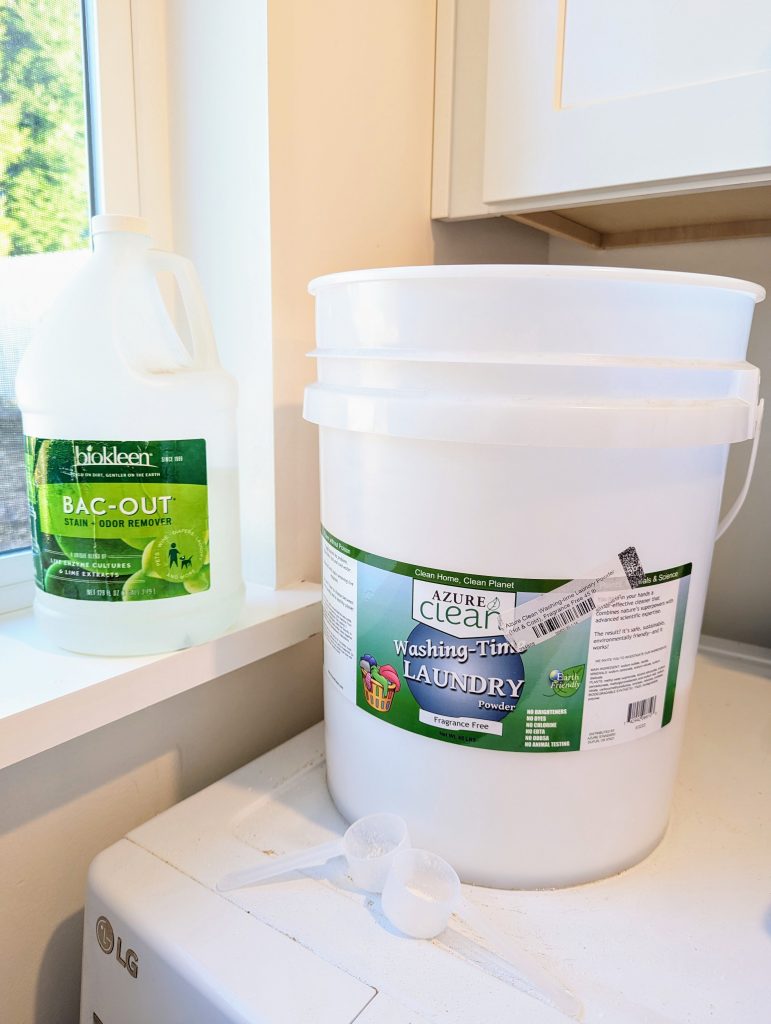
but have used the others listed below with good results as well.
- Molly’s Suds Baby Laundry Detergent Powder
- Rockin’ Green Classic Rock Laundry Detergent
- Country Save Laundry Detergent
Avoid using fabric softeners and washing liquids or powders containing fabric softeners, as they can build up on fabric fibers, reducing diapers’ absorbency. I again strongly recommend fragrance-free options. Fragrances do not help clean. They do, however, cover up unclean odors. When using cloth diapers, you need to know if they are clean or not. Also, the chemicals in “fragrance” are trade secrets (proprietary blend) and are therefore not disclosed to the consumer. You will have no idea if they are safe or not.
Sometimes you may have a strong ammonia smell and will need to add in an enzyme laundry additive. BioKleen Bac Out (enzyme laundry additive) is what we use to get the urine smell out from time to time. Use it in an initial cold cycle in addition to your detergent. This is usually not needed for cotton items such as workhorse fitted diapers but can be beneficial if you are using synthetics such as microfiber.
Basic steps
Here are the basic steps to washing cloth diapers:
- Remove solid waste from diapers before putting them into your wet bag/pail as needed.
- Run the longest hot wash cycle you have on your washing machine with your chosen detergent. If you did not pre-soak your diapers, you will need to do a prewash.
- Rinse the detergent from the diapers. If you have hard water try to only do this one time. Otherwise, you can use several rinse cycles to do so.
- Dry your diapers in your method of choice. I do not recommend machine-drying diaper covers on high heat as it can degrade the waterproof layer.
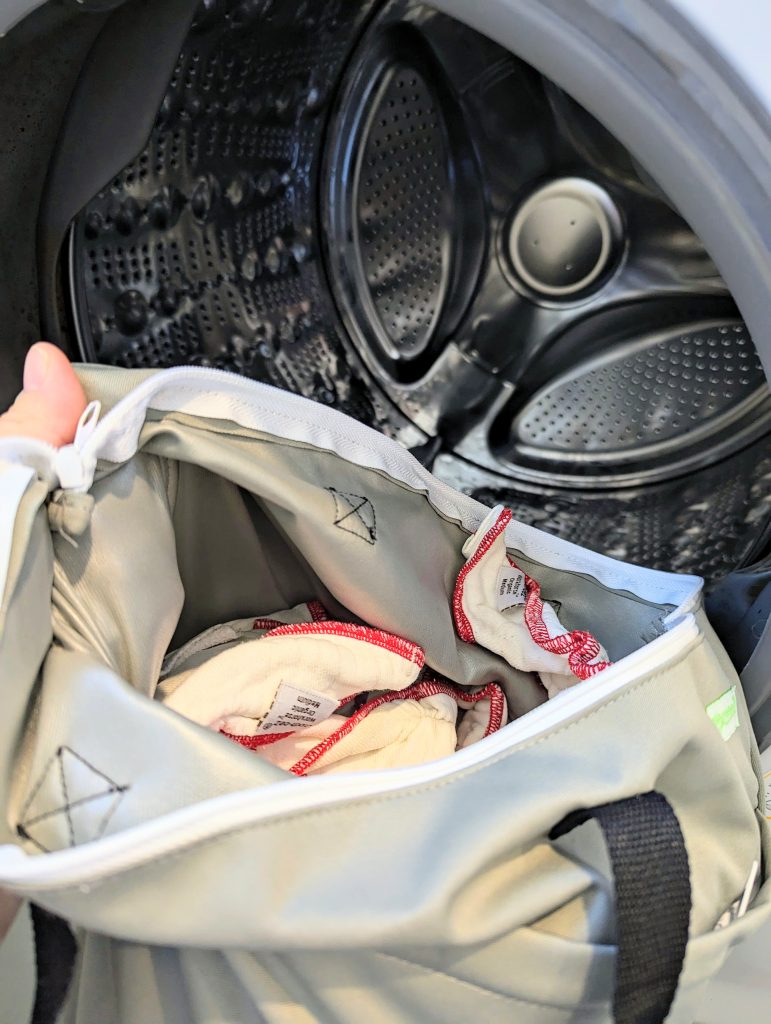 Dirty cloth diapers in wet bag
Dirty cloth diapers in wet bag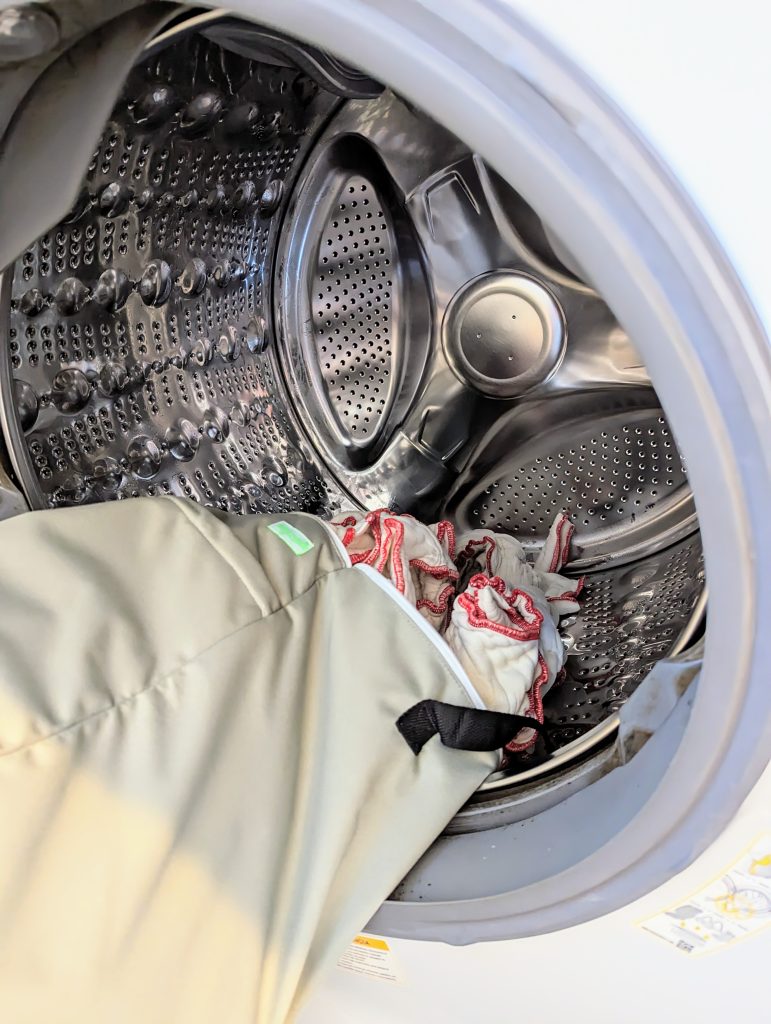 Dirty cloth diapers in wet bag going into HE front load washer
Dirty cloth diapers in wet bag going into HE front load washer Laundry detergent I use and the biokleen Bac-Out
Laundry detergent I use and the biokleen Bac-Out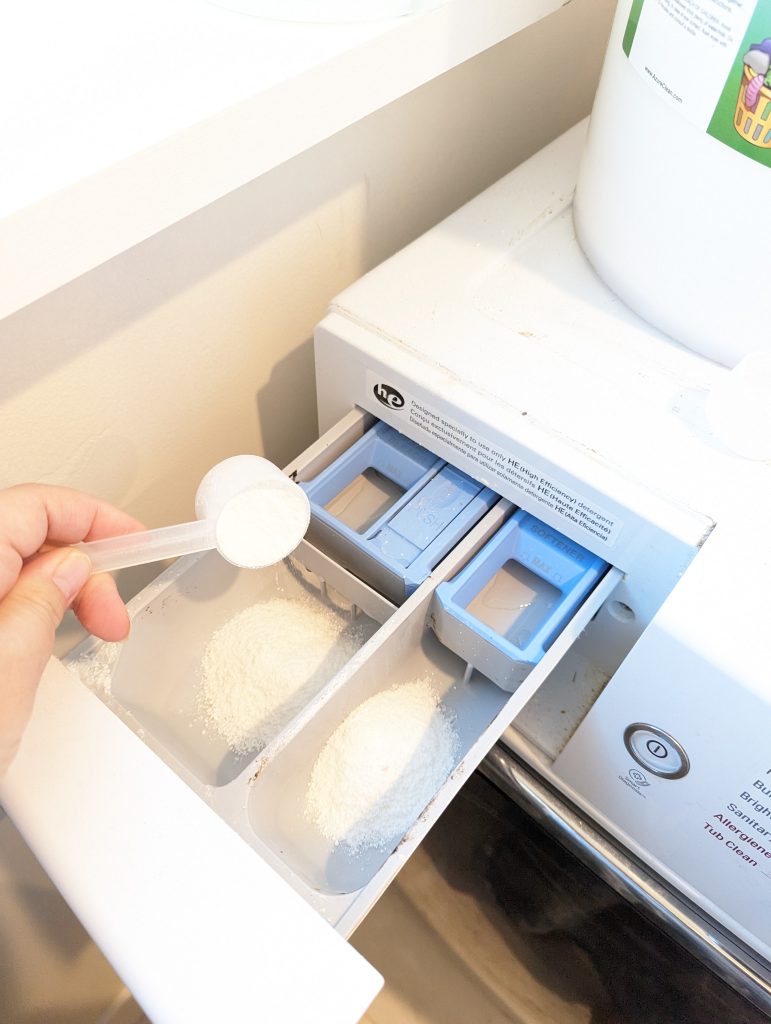 Laundry detergent in prewash and main wash
Laundry detergent in prewash and main wash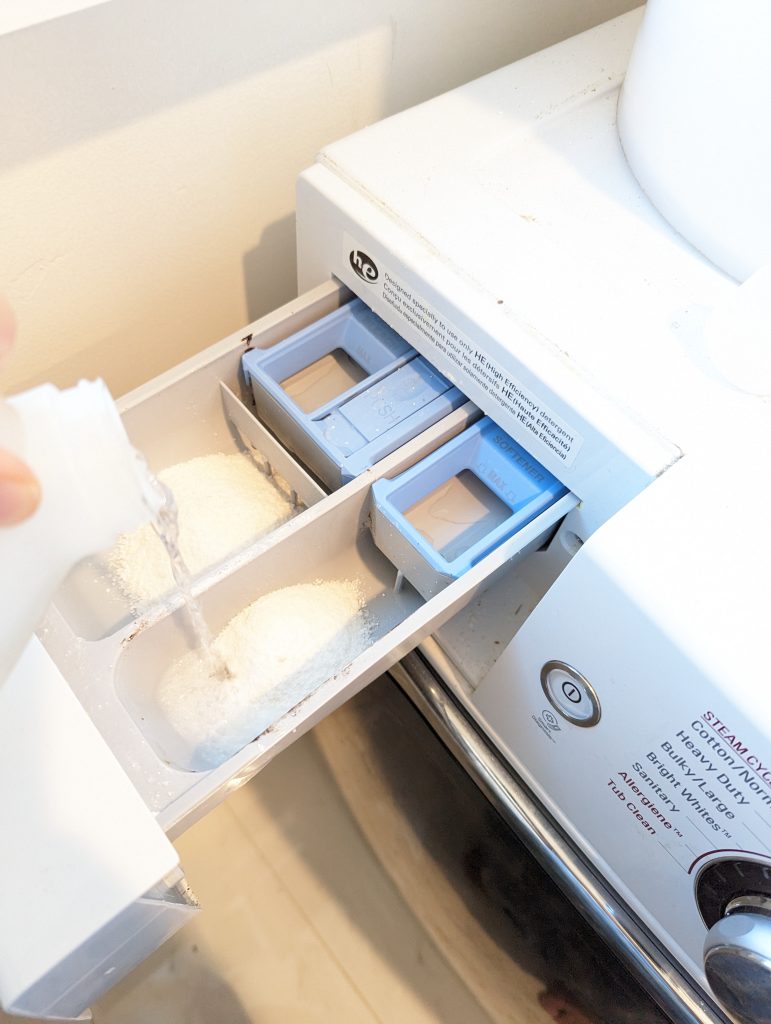 Adding biokleen to the prewash
Adding biokleen to the prewash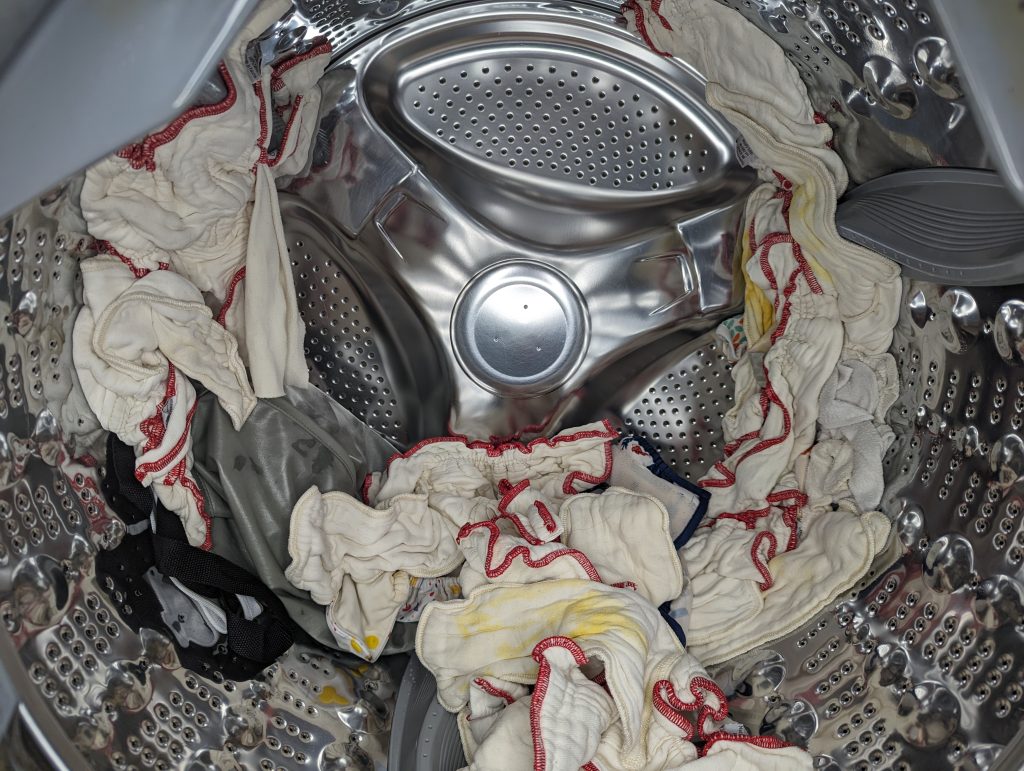 Cloth diapers after the wash cycle
Cloth diapers after the wash cycle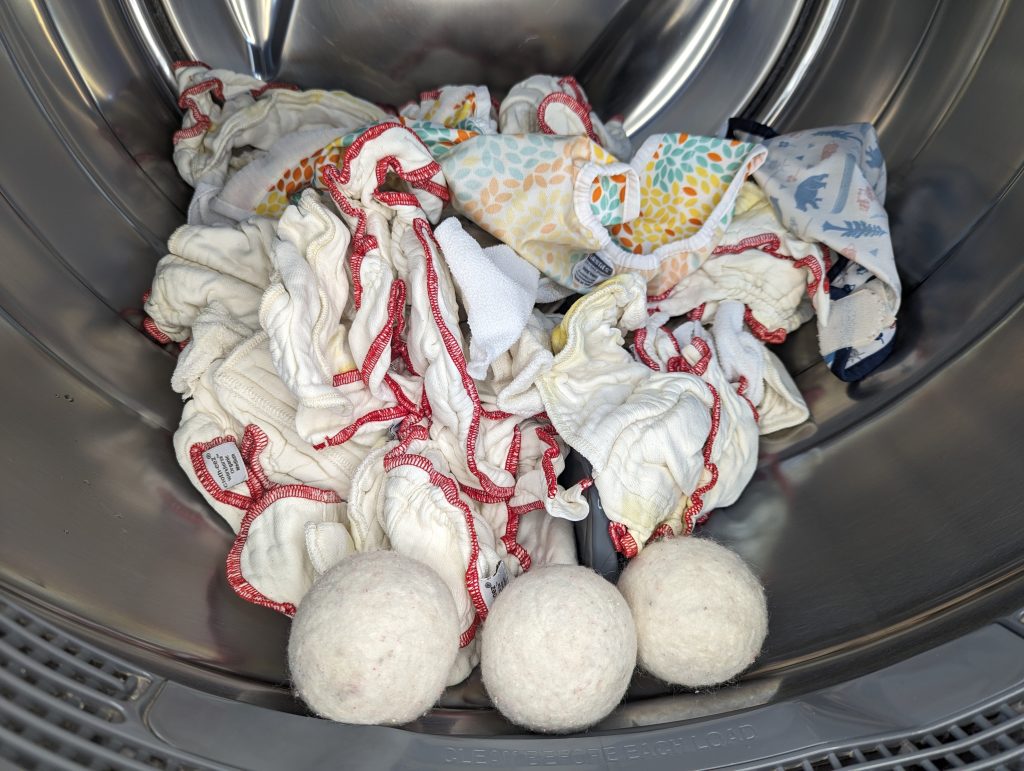 Wet cloth diapers in the dryer with 3 wool dryer balls
Wet cloth diapers in the dryer with 3 wool dryer balls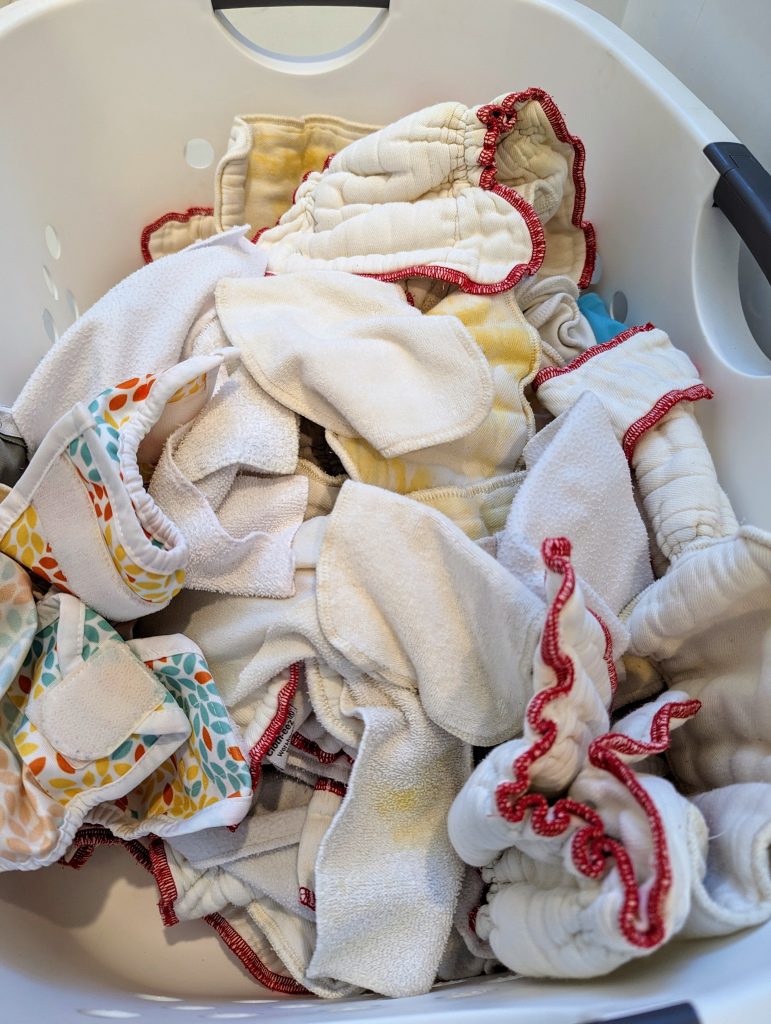 Fresh clean and dry cloth diapers
Fresh clean and dry cloth diapers
Tips and tricks
Here are some tips and tricks that I have learned over the years. Some of these may or may not work for you and your particular situation. Please use your discretion and research before implementing.
Urine smell?
If you have a urine smell in your diapers, we use the BioKleen Bac Out in the prewash cycle. It works very well.
Can you use bleach?
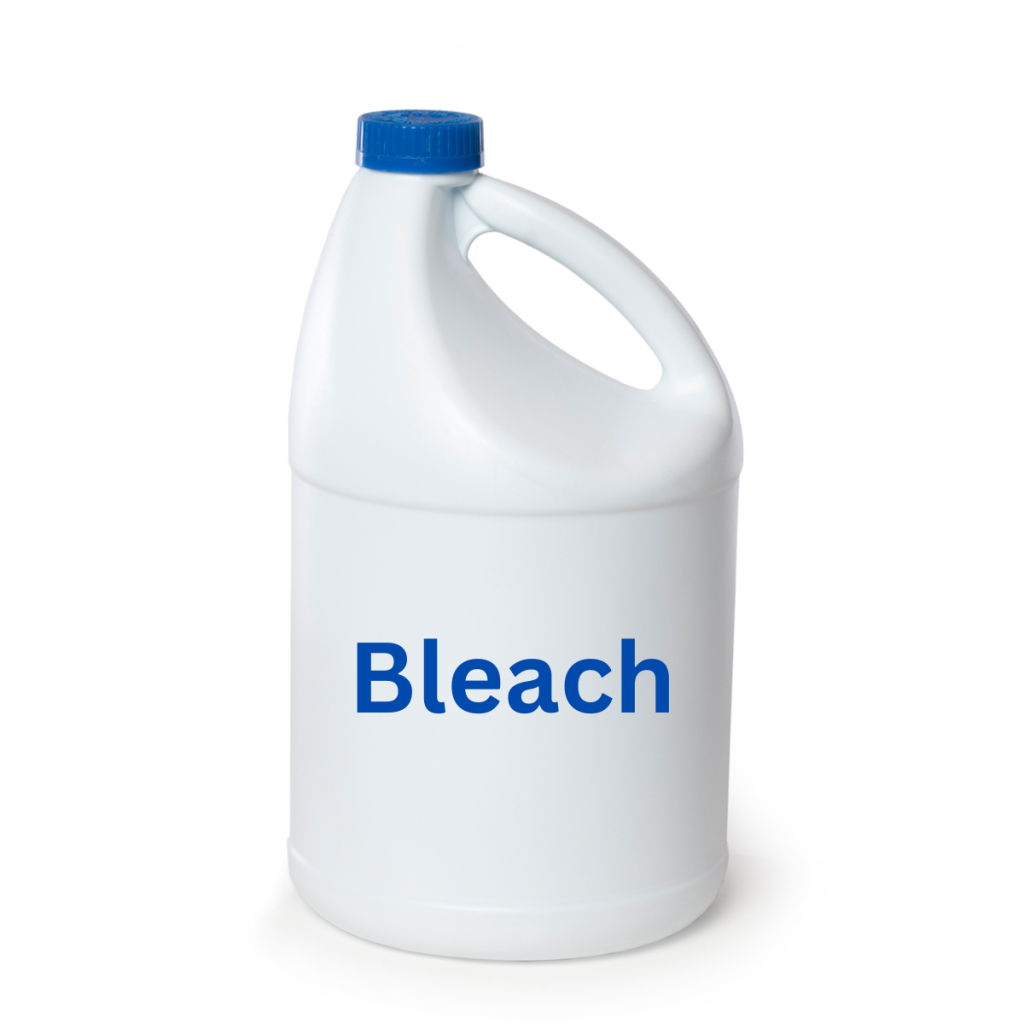
You can use bleach but very sparingly. It can degrade your diapers over time. Sometimes adding a small amount of diluted bleach is useful if you run into odor problems. I use diluted bleach every once in a while, but that’s every couple of months if so. Make sure to rewash and dry again after bleach is used. You want to make sure that there is no trace of bleach left in the diapers before you put them on your baby’s skin.
Hang to dry
Use a clothesline or something similar whenever possible to dry your cloth diapers. Hang-drying these is best to maintain their function. Using a clothesline for all the diapers is best to preserve the diapers for long term. I used something like this for years. It’s fairly inexpensive and versatile. I used it inside the home, patio, and in the front yard when I could to sun out the stains.
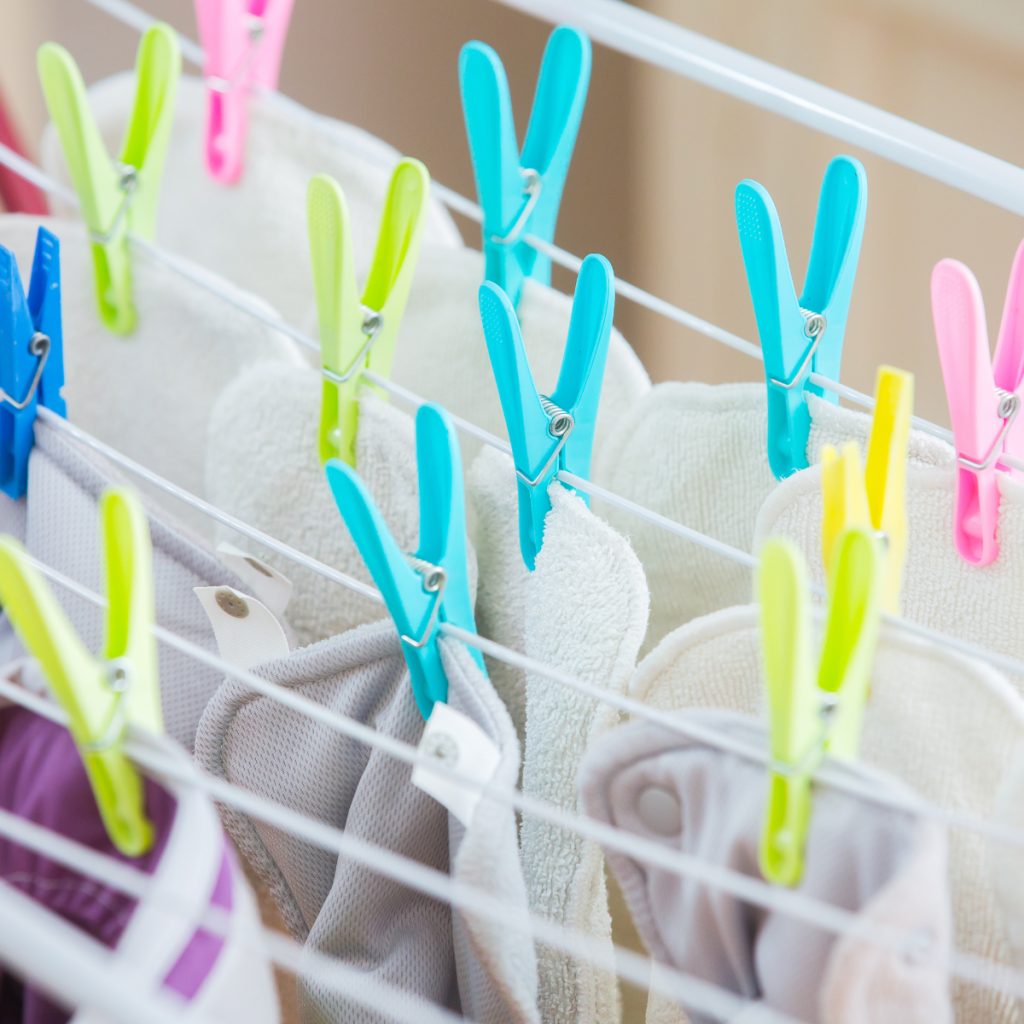
Even if you have hard water, you still need to rinse well. Even if we are told not to extra rinse with hard water because of mineral build-up. Laundry detergent not rinsed properly from diapers will cause red/irritated bottoms. You will need to make sure and get all the detergent out of the diapers. I cannot tell you how much to rinse and neither can anyone online. Only you can figure out what works in your water and wash situation from your observations and experiences.
Community washing machines
Do you live in an apartment and need to use community washing machines? I highly suggest you pre-soak your diapers in a wet pail or use a diaper sprayer to have the diapers fairly cleaned off before putting them into the washing machine. Use a regular cycle twice on hot with mainstream fragrance-free detergents. These are recommended for shared laundry facilities because the majority of other users are using mainstream detergents as well. I recommend doing an extra rinse cycle if possible.
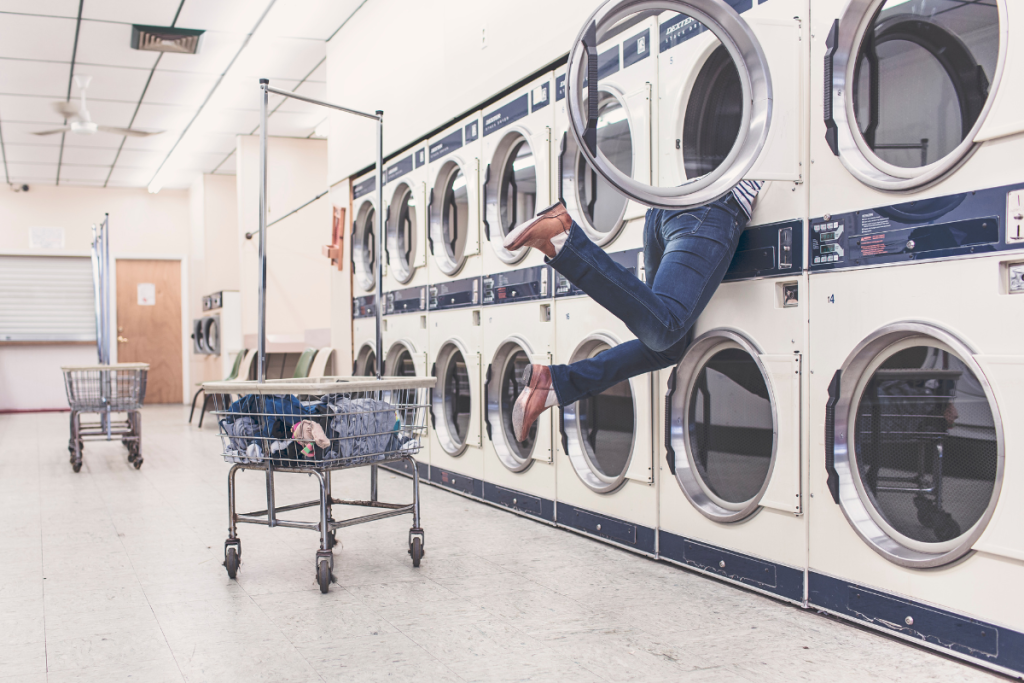
Are they clean?
How can you tell if a cloth diaper is clean? Put it to your face and smell it. It’s that simple. If you wouldn’t put it to your face to smell, then it is not clean enough to be on your baby’s skin. It should smell clean or like nothing at all. Never use fragrances to cover up any smells. If they are not clean, wash them again. If you feel like your washing routine is not getting the job done, you may need to strip the diapers to start fresh and then troubleshoot your washing routine.
Stripping cloth diapers
Stripping cloth is a method to remove mineral or bacteria buildup to help diaper fabrics come out cleaner and more absorbent. Buildup with minerals often happens from washing your cloth diapers regularly in untreated hard water. It may also happen from using too much detergent, fabric softeners, or even diaper creams. The laundry strip helps to get the ammonia smell out of cloth diapers and improves their absorbency. This process does not need to be part of your regular wash routine. Only in certain circumstances will you need to strip your cloth diapers.
When you should strip your diapers:
- You notice a bad odor even after washing several times.
- Your cloth diapers may seem clean but right after your baby pees, they smell awful.
- You notice less absorbency even after checking for fit on your baby.
- The diapers may have mildew or something similar from being left unwashed for too long. You will know this smell if it happens in your home.
- Receiving or buying pre-loved cloth diapers.
It may surprise you to know that there is a market to buy used cloth diapers. This market was huge over 10 years ago, but I think it has died down some. However, because you can buy used cloth diapers, you want to wash them by way of stripping for the initial washes. This is to get out any of the old detergents, and potential build-ups and to make sure they are as sanitary as possible for your baby.
It is a relatively easy process. You can just run a few hot wash cycles with just water or you can add in a very small amount of bleach if desired, but always double-check with your cloth diaper manufacturer’s recommendations before doing so. Otherwise, you can use vinegar, Dawn dish soap (not in a HE machine), or RLR soak.
Vinegar
To use vinegar, put 1/2 or 1 cup of white vinegar in the rinse cycle. It removes detergent buildup and hard-water minerals and neutralizes the ammonia from urine.
Dawn dish soap
If you want to use Dawn dish soap you will add one tablespoon of the original blue liquid Dawn dish soap to your tub or top-loader. Do NOT add it to your HE washing machine.
RLR soak
The RLR soak can be done with up to 30 diapers per packet. You add the packet to hot water in a container like a bathtub and let the diapers soak for several hours.
They’re clean!
Congratulations your cloth diapers are now clean and ready to be used! I hope that you have found this guide on washing cloth diapers helpful. Please let me know in the comments below what your wash routine is like.

